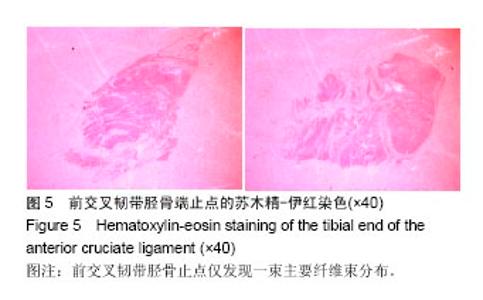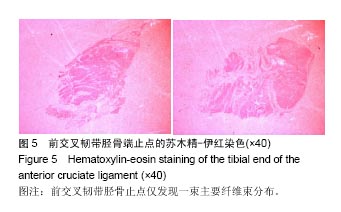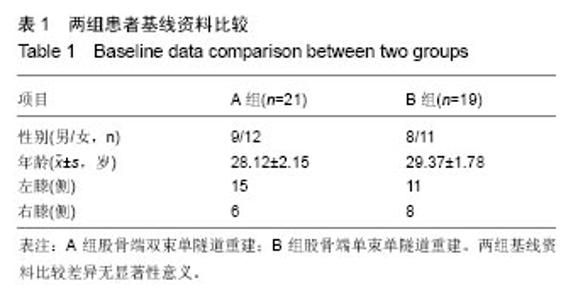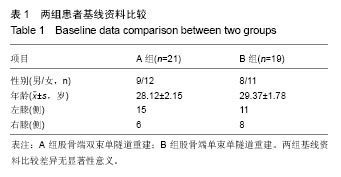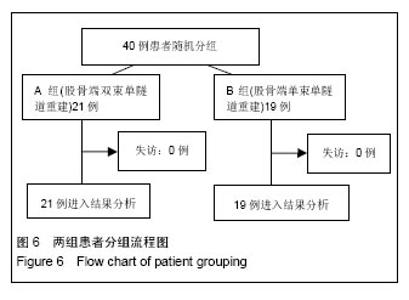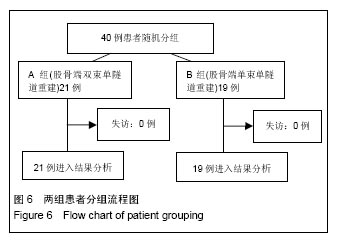| [1]Huston LJ, Greenfield ML, Wojtys EM. Anterior cruciate ligament injuries in the female athlete. Potential risk factors.Clin Orthop Relat Res.2000;(372):50-63.[2]Freddie H Fu, Christopher D Harner, Kelly G Vince. Knee Surgery. Volume One. America:Williams&Wilkins.1994:278 [3]Harter RA, Osterniq LR, James SL, et al. Long-term evaluation of knee stability and function following surgical reconstruction for anterior cruciate ligament insufficiency. Am J Sports Med.1998;16:434-443[4]Higgins LD, Taylor MK, Park D, et al. Reliability and validity of the International Knee Documentation Committee (IKDC) Subjective Knee Form. Joint Bone Spine.2007;74(6):594-599.[5]American board of orthopaedic surgery. research committee report in dip lomatic newsletter. Chapel Hill, NC: ABOS; 2004:8[6]Barker JU, Drakos MC, Maak TG, et al. Effect of graft selection on the incidence of postoperative infection in anterior cruciate ligament reconstrustion. Am J Sports Med. 2010;38(2);281-286.[7]Chang SK,Egami DK,Shaieb MD,et al.Anterior cruciate ligament reconstruction:allograft versus autograft,Arthroscopy. 2003;19 :453-462.[8]Woo SL, Kanamori A, Zeminski J, et al. The effectiveness of reconstruction of the anterior cruciate ligament with hamstrings and patellar tendon. A cadaveric study comparing anterior tibial and rotational loads. J Bone Joint Surg Am. 2002:84:907-914[9]Yagi M, Wong EK, Kanamori A, et al. Biomechanical analysis of an anatomic anterior cruciate ligament reconstruction. Am J Sports Med. 2002:30:660-666[10]丁清和,叶勇光,向孝兵,等.关节镜下经前内入路建立股骨骨道重建前交叉韧带的疗效观察[J] .岭南急诊医学杂志, 2014,19 (4 ):323-234.[11]Cha PS, Brucker PU, West RV, et al. Arthroscopic double-bundle anterior cruciate ligament reconstruction: an anatomic approach. Arthroscopy.2005;21 1275.e1-8. [12]Ishibashi Y, Tsuda E, Tazawa K, et al. Intraoperative evaluation of the anatomical double-bundle anterior cruciate ligament reconstruction with the OrthoPilot navigation system. Orthopedics 2005;28:1277-1282. [13]Yasuda K,Kondo E,Ichiyama H, et al.Anatomic reconstruction of the anteromedial and posterolateral bundles of the anterior cruciate ligament using hamstring tendon grafts. Arthroscopy 2004;20(10):1015-1025.[14]尤田,张新涛,张文涛,等.中国成人前交叉韧带胫骨止点的解剖研究[J].中国修复重建外科杂志,2015,29(6):730-733.[15]Zantop T, Petersen W, Sekiya JK, et al. Anterior cruciate ligament anatomy and function relating to anatomical reconstruction. Knee Surg Sports Traumatol Arthrosc.2006;14: 982-992.[16]赵双利,王世轩,李洪涛 .前交叉韧带重建术中股骨隧道定位方法的发展趋势[J].中医正骨,2015, 27(8 ):63-65.[17]李文凯,吴华,韦盛,等.关节镜下解剖位与过顶位前交叉韧带单束重建的近期疗效对比[J]骨科,2015, 6 (3):113-116.[18]张理选,李映姗,张华胜,等.经前内侧入路个体化解剖重建前交叉韧带的临床分析[J] .右江民族医学院学报,2015, 37(3):419-427.[19]OdenstenM, Gillquist J. Function anatomy of anterior cruciate ligament and a rationale for reconstruction. J Bone and Joint Surg.1985;67: 257-262.[20]Howell SM, Taylor MA. Failure of reconstruction of the anterior cruciate ligament due to impingement by the intercondylar roof. J Bone Joint Surg Am.1993;75: 1044-1055.[21]Amis AA, Zavras TD. Isometricity and graft placement during anterior cruciate ligament reconstruction. Knee.1995;2:5-17.[22]Beynnon BD, Johnson RJ, Abate JA,et al. Treatment of anterior cruciate ligament injuries, part 2. Am J Sports Med. 2005;33:1751-1767.[23]Fu FH, Bennett CH, Ma CB, et al. Current trends in anterior cruciate ligament reconstruction. Part II. Operative procedures and clinical correlations. Am J Sports Med 2000;28:124-130.[24]Good L, Odensten M, Gillquist J. Sagittal knee stability after anterior cruciate ligament reconstruction with a patellar tendon strip. A two-year follow-up study. Am J Sports Med. 1994;22:518-523.[25]Sommer C, Friederich NF, Müller W. Improperly placed anterior cruciate ligament grafts: correlation between radiological parameters and clinical results. Knee Surg Sports Traumatol Arthrosc 2000;8:207-213.[26]Moisala AS, Järvelä T, Harilainen A,et al.The effect of graft placement on the clinical outcome of the anterior cruciate ligament reconstruction: a prospective study. Knee Surg Sports Traumatol Arthrosc.2007;15(7):879-887. [27]马亮,许永涛,佘远举,等. 关节镜下经前内侧入路个体化解剖重建前交叉韧带的疗效观察[J]. 中国内镜杂志,2016, 22(3): 51-56. |
